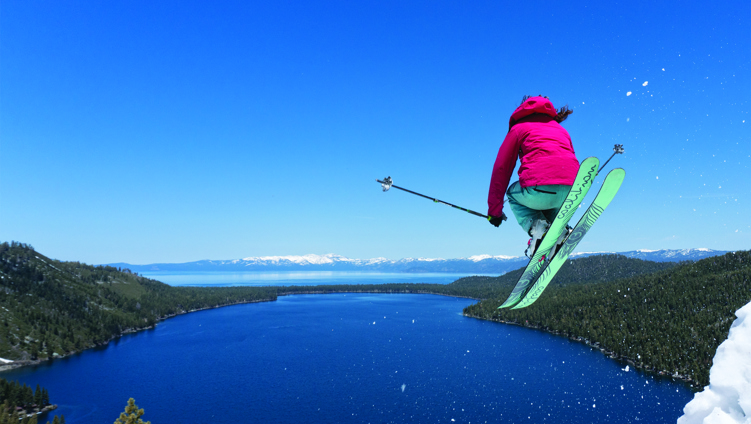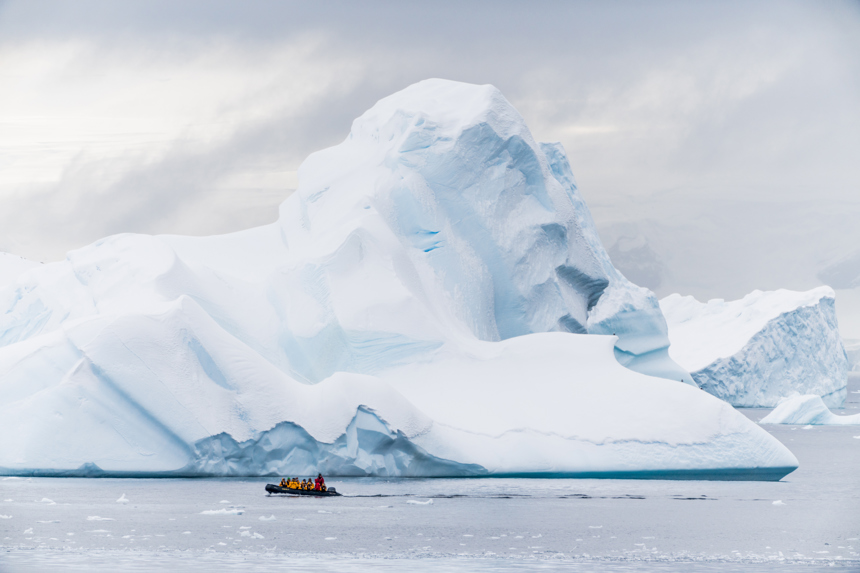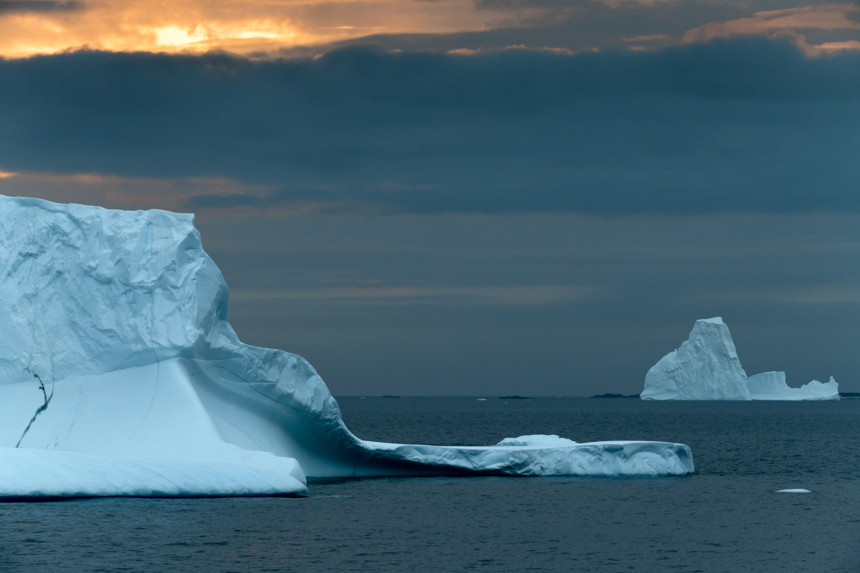In this long read, Fraser Morton interviews legendary polar explorer Sir Robert Swan, and recounts a life spent pushing limits and working tirelessly for polar conservation.

In this long read, Fraser Morton interviews legendary polar explorer Sir Robert Swan, and recounts a life spent pushing limits and working tirelessly for polar conservation.
Behind him, the history of his polar achievements played on his thoughts. His Last 300 Expedition. A final walk to the South Pole. A fitting name for the final chapter of a 33-year Trans-Antarctic crossing on foot — and a life dedicated to protecting the polar regions.
“Not for records, not for anyone. This one's for me. Do what you say you are going to do.”
He peered into the white abyss and felt familiar awe and dread. Not easy to describe, but inescapable in his dreams. A pull, like a magnet, sliced through the empty landscape and stabbed into his heart.
“I shouldn’t even be here,” he thought.
The distant call of the wild places had started in his childhood and echoed through his life as an ever-present tug at his insides. It had hardened his body, moulded his will and pushed him further than he could have imagined.
The first person to walk to both poles: South (1986) North (1989). The Polar Medal. An Officer of the British Empire. A United Nations Ambassadorship for Youth, The Special Envoy to UNESCO. A mentor to thousands of environmental activists around the world. But mainly, he was a survivor of the polar places, and all because of the landscape’s silent call from his childhood.
And so, on what was meant to be his final expedition to the South Pole, he stood - his feet in boots and clipped in skis, wrapped head-to-toe in layers of survival clothes - and peered out through masked vision upon a landscape where he would face a final test.
The first step of thousands lay ahead. As did the sound of his skis and sticks pounding snow, accompanied by the crunch, swoosh, slap, and grunts of relentless, monotonous marching while dragging his heavy sled. Exhaustion, disorientation, sleeplessness awaited somewhere out there on the ice. As did soon to be spoken “shits”, “damn its” and “bloody hells” over inevitable, tiny, errors in judgement by a soon-to-be-sleep-and-oxygen-deprived brain. Punishment awaited in frozen fingers, frostbitten toes, chafed and bloodied thighs and absolute bone-rattling exhaustion for this 63-year-old man. He had planned for all potential pitfalls his imagination could dream up. This time, he felt prepared. His new hip had healed. He had trained for two years. He felt strong. He pushed away thoughts of agony on the ice two years ago.
“Game on,” he thought.
And then came the first step. On December 2, 2019, Briton Sir Robert Swan began what was to be his last 300-mile march to the South Pole.
Swan had earned his place alongside the great explorers to have tested their physical and mental strength to the limit in the planet’s most hostile environments, but his 1980s expeditions also marked the beginning of a new phase in his life. On both marches, he experienced the effects of climate change on the polar icecaps. This shaped his mission to draw attention to the plight of the polar regions through activism, and while doing so, also keep a promise to his friend, legendary French ocean explorer Jaques Cousteau, who had told Swan in the early 1990s: “You must work to protect Antarctica” by raising awareness of the plight of the polar regions and protection of the Antarctic Treaty.
Shortly afterwards, Swan founded 2041 Foundation, named after the year the Treaty is set to expire. The Treaty is hailed as one of humanity’s greatest conservation agreements, designating the continent as a land of science and peace. A broken treaty would be disastrous for Antarctica, with national interests entering the greater picture, inevitably leading to the commercialisation and industrialisation of the continent, with mining, overfishing and anti-pollution protections eroded and increased climate change wreaking havoc on the already depleting ice shelves. Swan and his organisation are determined to make sure the Treaty is once again signed.
Photo: Copyright Fraser Morton, Far Features.com

In 2017, nearly 28 years after his polar expeditions of the 1980s, Swan’s 24-year-old son Barney convinced his father to join him on an expedition to the pole called The South Pole Energy Challenge. The idea came after the pair visited a NASA facility and were shown a map of Antarctica highlighting the imminent threat of a break up of the massive Antarctic Larsen C ice shelf due to climate change.
Swan was breaking a promise to himself. This was the second time he had broken polar retirement.
“When I reached the North Pole on May 14th, 1989, I didn’t just hang up my skis. I screwed them to the wall. This was never going to happen again.”
“NASA was saying, ‘no one is listening to us. We need to get people taking this seriously.’”
Soon after, the younger Swan founded the Climate Force Challenge, a seven-year mission to clean up 326 million tonnes of Co2 by the year 2025 by championing clean energy use and working on clean-up missions worldwide. To Launch Climate Force, father and son would undertake The South Pole Energy Challenge (SPEC).
After celebrating his 61st birthday, Swan pencilled in December 2017 as the SPEC starting date. “The dreams of the 11-year-old in me were reborn. I felt like there was this unfinished line across Antarctica. The dream was now to cross the entire Antarctic landmass over 33 years.”
In December 2017, Swan senior and Barney set out in a team of four on a 600-mile march that would become the world’s first renewable-energy powered expedition to either Pole.
NASA ice melters powered by the sun adorned their sleds, biofuels boiled their meals and daily audio and visual broadcasts were beamed back to the world with live messages for their following fans.
They hauled sleds that weighed over 100 kilograms. As the march wore on, every muscle in Swan’s then 61-year-old body began to ache. His harness cut and chafed, leading to bloodied skin. Frostbite set in. Gripping his ski sticks numbed his frozen hands. Barney’s toes began to rot. And what started as discomfort in Swan’s hip fast developed into long days of agony and sleepless nights under the midnight sun.
It had been thirty years to the month since he had walked to the pole, but looking around, the place hadn’t changed a bit. It was a timeless, empty landscape. The only thing in sight to have aged was him. The game had changed. His mind kept racing back and forth between 1987 and 2017, step by step, decade by decade. The lines of time began to blur.
As the 2017 march wore on, Swan began to fall further behind each day, and eventually, 31 miles away from the midway point of their 600-mile march, had to throw in the towel. His hip had disintegrated, the bone worn down by years of marching.
Barney and the team continued on, finishing their march on January 15, 2018.
“That was so terrible for me because I was beaten. And it hadn’t happened before. Antarctica had slapped me in the face. It hadn't let me through.”
While the expedition was deemed a team success by proving that even in the harshest environment on Earth it is possible to survive on renewable-energy technology, Swan had the hard truth of accepting his own limitations.
In early 2018, he underwent a hip replacement surgery in the United Kingdom. Upon return to the USA, he began planning another retirement vacation back to the South Pole. In big bold letters he wrote “Last 300” in December 2019 in his calendar.
By early 2019, Swan had assembled a team, and preparations for the Last 300 expedition were gathering pace. He enlisted Swede Johanna Davidsson, a record-holder as the fastest woman to ski from the coast of Antarctica to the pole unsupported; Norwegian cross-country skier and guide Kathinka Gyllenhammar; and South African-Norwegian filmmaker Kyle O’Donoghue, who had marched with Barney to the South Pole on SPEC two years earlier.
Swan continued to give lectures throughout the year, travelling to 27 Nations to give motivational talks about survival, leadership and sustainability at conferences, schools and universities as he had done for the past 30 years. Every ton of carbon he produced was cleaned up by Barney’s Climate Force mission. All the while, plans for his next polar walk ticked along behind the scenes.
“I ask lots of people to take small steps towards sustainability and our survival on the planet. I said I was going to do one final walk, and I thought, ‘I’m bloody going to finish the crossing of the Antarctic landmass.’”
Months of gruelling training followed, and his new hip grew stronger.
On December 2, 2019, Swan and the team boarded a prop plane at the Union Glacier base camp run by Antarctic Logistics Expeditions (ALE). They flew over the vast icescape and the route Swan had previously walked and landed at the “exact same patch of snow” where he had been airlifted out two years earlier.
The team was 300 miles out from the pole. Swan sent a short message via sat phone, which beamed their location to the GPS tracker on the 2041 Foundation website: “Landed, the journey begins!”
His training had paid off. His hip had healed. His doctors were happy. And he felt physically and mentally ready. The team made a steady pace over the first 100 miles amid sweltering conditions for Antarctica.
“It’s almost boring to say with these records being broken on a daily basis – but it was the hottest weather ever at 85º and 86º South. When you think of the -20ºC temperatures that Scott and Shackleton had at those latitudes, we had -5 ºC. It’s kind of unbelievable. But while the surfaces were a bit strange, we got stuck in.”
All Swan had to do was get to 89º South, 60 miles from the pole, where his son Barney and his Last Degree expedition team of five would be waiting, and then they would all march the last 60 miles in celebration together to the pole.
“I would have completed the crossing of the Antarctic landmass and we would undertake the celebration walk. A great trip all together. That was the plan. Get to 89º South, job done.”
Photo: Copyright Fraser Morton, Far Features.com

In extreme environments, ordinary can quickly become extraordinary. One of the less-documented daily routines that Antarctic explorers must face on their heroic marches to the pole is the humbling, ordinary daily tasks of going to the loo. Imagine, for a moment, trying to relieve yourself outside with no toilet in -30ºC temperatures, your bare bum revealed to the icy winds in climatic conditions so fierce that skin exposed for more than a few seconds can be ravaged by frostbite.
“Obviously when you go to the loo in Antarctica, you are not sitting on a lavatory seat. You go outside, -30ºC, you whip your trousers down and you squat over a hole that you have dug,” Swan said.
Each morning, like clockwork, the team took turns in going to the loo before setting off on their day’s march.
On day seven Swan was first out of his tent for the morning ritual. He dug a hole, whipped down his trousers, bent over and, in that instant, “bang, like an electric shock shooting up my leg and into my hip. It felt like somebody pulled a wine cork out the bottle, but it was inside my hip. In agony, I leaned to one side and it popped back in. All I could think was ‘oh, shit’”.
Shaken, he carefully walked back to the tent and told his tent mate, Kyle: “I have a problem.”
The pair hatched a plan. No hip bends — at all. Swan would have to think through every tiny muscle movement of his hip, no matter how mundane the task for the rest of the march. This was a potential expedition-stopper for Swan less than a quarter of the way into the march. He had to be extra careful. “I knew I couldn’t get distracted by the cold and had to focus on what I was doing.”
Swan and the team pressed on. Days passed of utter exhaustion and seven hours of marching. Weary each night, Swan sent updates via sat phone to his following fans. And as the march wore on, he had no hip issues. Morning toilet trips went by undisturbed. At night-time in the tent, he felt pinches in his hip and struggled to sleep. He was almost there. Swan’s 33-year mission: 1,460 miles total, 40 to go.
On the morning of Day 29, Swan unzipped his tent and stepped out onto the ice desert of Antarctica. He looked around and peered into the nothingness. A familiar cold snap rattled him, and he recorded the temperature at -30ºC. He knew, as they continued to rise in altitude to the South Pole, it would only get colder from here on. As he walked away from camp, his mind raced with thoughts about how close they were to the pole, and how near he was to completing his goal. It was a matter of a few miles. He could almost touch the finish line.
“And so, as I go to the loo, I am not thinking about taking my time. I am thinking about how close we are to the pole,” Swan recalled. He whipped down his trousers, squatted and “bang, the hip just came out of its socket and I looked down and the whole head of the hip, the metal head was pushing out my skin. Not piercing the skin, but out of the joint. It was unbelievable pain, like an electric shock that would not let go. Normally, you touch electricity and let go right away. But it wouldn’t stop. I was lying there unable to move.”
A mere 40 miles to the South Pole, Swan found himself paralysed on the ice in blinding pain unlike anything he had experienced. Within seconds the -35ºC icy chill seeped into his exposed skin and sent uncontrollable shudders through him. As he lay gasping for breath in the snow, his eyes locked on something strange across the ice desert on the white horizon: a figure in the distance coming closer.
“I thought I was dying. I could feel the cold seeping into my skin. As this electric shock feeling was going through me, I looked up and I saw a figure walking towards our camp. We were in the middle of a continent twice the size of Australia and there was no one else there, and all I could think was ‘fantastic, this is it - it’s the Grim Reaper coming to collect me and I'm dying.’ I thought maybe I was having a heart attack with the pain. You don't suddenly see somebody in the middle of Antarctica. I shouted for Kyle and he came out, took one look at my hip, and said, ‘Rob isn't looking too good.’”
Kyle helped Swan make himself decent and Johanna and Kathinka came out and helped carry their injured teammate back to the tent.
“Meanwhile, this guy who I thought was the Grim Reaper was actually a polar explorer from Poland who hadn't seen anybody for 49 days. He had been following our tracks and walked straight into our camp. Johanna asked him if he knew how to put a hip back in its socket. He shook his head and kept right on marching. We found out he made it to the pole a few weeks later.”
The team bundled Swan into his tent and assessed the damage.
“I'm lying in the tent and I know it's over. Forty miles off after all that fight. Two times knocked back. Right then, I said to the team, ‘we will come back and finish this.’”
The team radioed ALE (Antarctic Logistics Expeditions) for an air evacuation. Once again, Swan made the “depressingly short flight” to the South Pole. Upon arrival, Swan was stretchered off and loaded into a tent operated by ALE .
The hip simply had to go back in. As luck would have it two doctor friends of Swan, Dr. Martin and Dr. Hans, happened to be at the South Pole base. And so, on the tent floor a few yards away from the South Pole, the two doctors administered pain medications, letting the drugs take effect, before pushing down on Swan’s out-of-socket hip in an effort to pop it back in.
“Simply awful,” Swan recalls. “I wept tears of failure again.”
Swan was flown back to the Union Glacier base camp where he met son Barney and his Last Degree team who were preparing for their own expedition to the South Pole. It was a bitter disappointment as Swan senior watched his son’s team depart.
Kyle, Johanna and Kathinka would continue to 89º South to meet the Last Degree and then carry on to the South Pole. Barney and his team made also made a successful attempt, reaching the pole on January 13th 2020.
“That’s twice now he’s made it to the South Pole without his Dad. Pretty remarkable. And I think that's a huge message of hope for the younger generation and leadership on his part. That is a huge message for our survival on this planet. It has to be that we work together as generations because if we don't, we're screwed.”
A few days later, Swan senior arrived home to California on crutches.
“I was never disappointed until I got back home and I saw the piles of paperwork that it took me to make the expedition happen - all the boxes of equipment. I thought, ‘My God, what an effort it took.”
Photo: Copyright Fraser Morton, Far Features.com

You can guess what’s coming. In December 2021, Swan plans to return to the South Pole.
Swan’s walking tales now are intrinsically linked to the 2041 Foundation and his support of Barney’s Climate Force Challenge.
As a UN Goodwill Ambassador and climate change campaigner for the past 30 years, Swan has spearheaded hundreds of clean-ups, eco-sails, educational programmes, and education and clean-energy hubs in countries worldwide. Young people, especially, are his audience, and he challenges them through his 2041 Foundation to become sustainable business entrepreneurs.
“Every day, I ask people to do their bit for sustainability. I think it’s a good example if I do what I say I am going to do on my part. I think it's important when people say they are going to do something, they do it.”
In 2021, Swan will be 65 when he plans his Last 40 with Barney.
“This may be the slowest walk across the continent of all time – 33 year - but I’m not in this for records. I’ve done that. This is personal and it’s to do what I said I am going to do.”
Swan plans to use his Last 40 to draw more attention to the plight of the polar regions and raise awareness for climate action worldwide. “I can’t leave it alone, with just 40 more to go, can I?”
In a small way, I hope my walks might be inspirational to people to not let go of dreams. No one's ever walked to the South pole with an artificial hip. I'm sure people would say, ‘Rob, you've done enough. There's no need. You proved your point. We're not going to be truly inspired by you going to finish off 40 miles.’ But you know, I'm not that sort of person. When I am lying in my bed as an old man, I just want to think, ‘Sure, it was a bit of a struggle getting knocked back twice, but I finished the job.’”
And if there was only one mile to go, would he still go back?
“Yeah, I would crawl it,” he said. “Rage until the dying of the light.”

